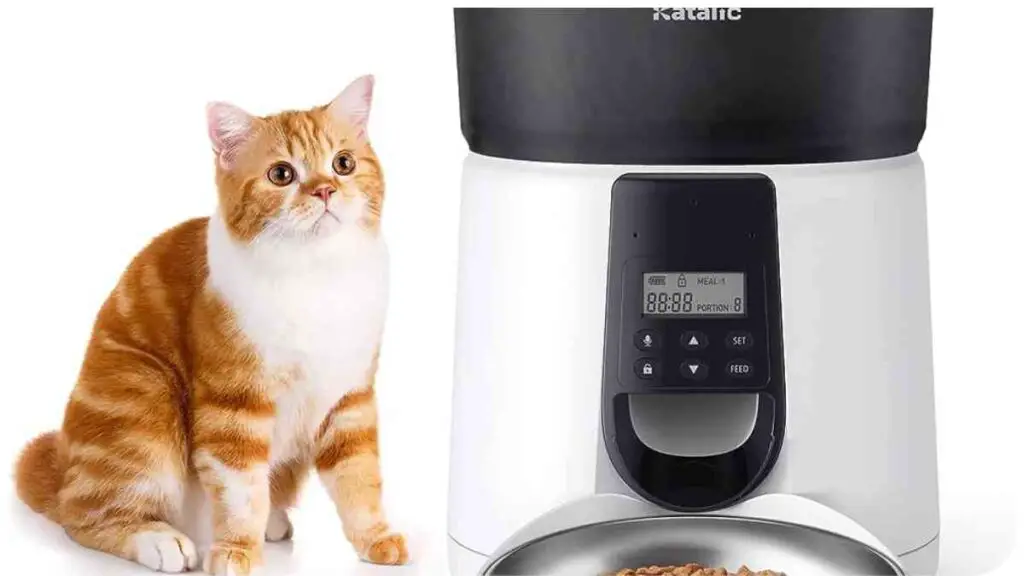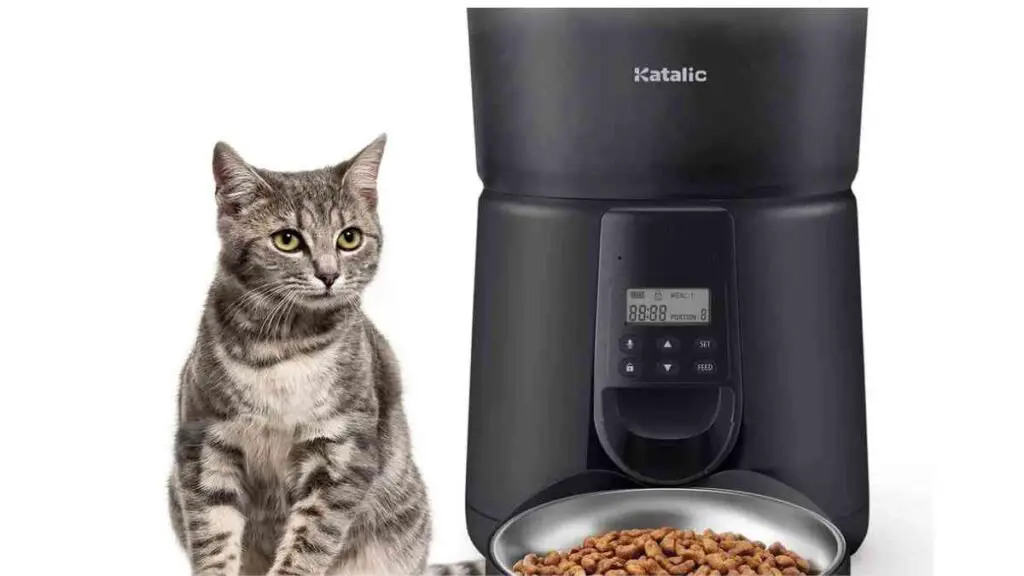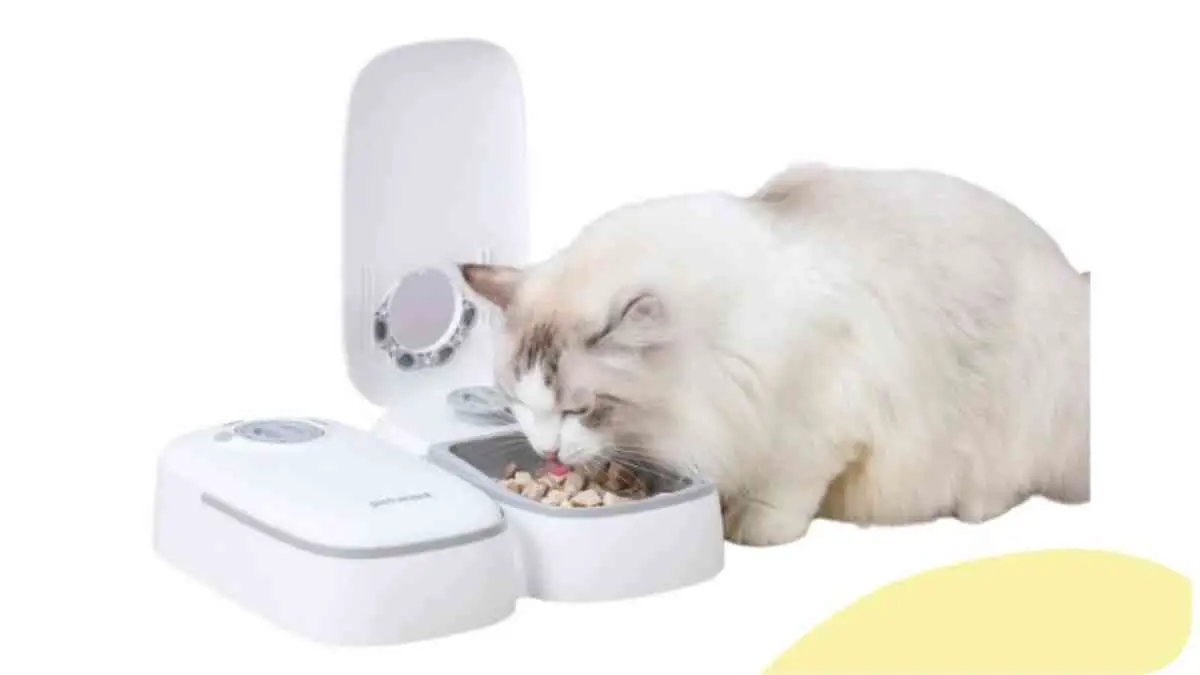Welcome, feline enthusiasts, to a comprehensive guide on a topic close to every cat owner’s heart: “Automatic Cat Feeder: Understanding Portion Sizes and Scheduling.”
| Takeaway |
|---|
| Proper portion control is crucial for your cat’s health. |
| Automatic feeders offer precise portion dispensing. |
| Consistent feeding schedules benefit your cat’s routine. |
| Cats have unique dietary needs; prioritize quality. |
| Consider your cat’s activity level when scheduling. |
| Gradual transition and monitoring ensure success. |
| Expert tips enhance the automatic feeding experience. |
| Multiple resources offer further insights and guidance. |
As a passionate cat lover and seasoned pet nutritionist, I’ve had the privilege of witnessing firsthand the transformative impact of proper feeding practices. In this article, we’ll delve into the nitty-gritty of portion control, feeding schedules, and the game-changing device that combines them seamlessly: the automatic cat feeder.
Table 1: The Benefits of Automatic Cat Feeders
| Benefits | Details |
| Precise Portion Control | Dispenses specific amounts, preventing overfeeding and underfeeding. |
| Consistent Feeding Schedule | Establishes routine, which is crucial for a cat’s well-being and digestion. |
| Great for Busy Lifestyles | Ideal for working pet parents; ensures your furry friend is never hungry. |
| Weight Management | Helps manage weight by controlling portions according to your cat’s needs. |
| Minimizes Food Wastage | Reduces the chances of food going stale or getting knocked over. |
The Importance of Portion Control for Cats
As responsible cat guardians, it’s essential to recognize that portion control isn’t just a human concern. Cats, like us, benefit significantly from regulated meal sizes. Imagine the impact on your health if you consumed random portions each day. The same applies to your feline companion. Obesity, diabetes, and urinary issues are just a few consequences of unchecked eating.
Think of your cat’s metabolism as a finely tuned engine. Providing consistent portion sizes ensures that their energy levels are steady, metabolism remains efficient, and weight stays within a healthy range. A common mistake is pouring food into a bowl without measuring, which can lead to overfeeding. Just a few extra kibbles each day might not seem like much, but over time, it accumulates.
When considering feeding requirements for puppies, it’s crucial to understand the ideal portion sizes. According to the Vet Answer, proper feeding contributes to a healthy growth trajectory.
Table 2: Cat Obesity: Facts and Figures
| Statistics | Details |
| Overweight Cats | Approximately 60% of cats in the U.S. are overweight or obese. |
| Health Risks | Obese cats are prone to diabetes, joint issues, and a decreased quality of life. |
| Lifespan Impact | Obese cats may live 2-3 years less than their healthy-weight counterparts. |
| Financial Burden | Treating obesity-related illnesses can lead to hefty veterinary bills. |
Benefits of Using an Automatic Cat Feeder

Enter the automatic cat feeder – a game-changer for pet parents striving to provide their furry friends with optimal nutrition. Here’s why this ingenious device deserves a spot in your home:
- Precise Portion Control: Automatic feeders dispense exact amounts according to your settings, eradicating the guesswork and ensuring your cat gets what they need, no more and no less.
- Scheduled Consistency: Cats thrive on routine. Automatic feeders offer a consistent feeding schedule, which can have positive effects on digestion and behavior.
- Regulation of Meal Frequency: Depending on your cat’s needs, you can schedule multiple small meals throughout the day, mimicking their natural hunting behavior.
- Ideal for Weight Management: If your cat needs to shed a few pounds, you can gradually reduce portions without sudden changes that might trigger hunger-related stress.
- Convenience for Busy Lifestyles: Modern life can be hectic, but your cat’s feeding routine doesn’t have to suffer. An automatic feeder ensures they’re fed even when you’re not around.
- Reduced Food Wastage: With manual feeding, spilled or stale food is a common issue. Automatic feeders minimize waste by dispensing only what’s needed.
- Peace of Mind: Going on a short trip? Automatic feeders provide reassurance that your cat won’t go hungry in your absence.
- Customizable Scheduling: Whether you’re a night owl or an early riser, you can program the feeder to dispense food at the times that suit you and your cat.
For pet owners, understanding how to manage weight is essential. Discovering how a puppy’s weight affects health, just like a Bichon puppy’s weight, adds insight into portion control.
Table 3: Factors to Consider When Choosing an Automatic Cat Feeder
| Factors | Details |
| Feeder Capacity | Choose a size that matches your cat’s daily food intake and refill frequency. |
| Power Source | Opt for battery-operated or plug-in models; consider a dual-power option in case of outages. |
| Meal Programming | Look for customizable meal schedules and portion sizes to cater to your cat’s individual needs. |
| Feeder Durability | Quality matters. Invest in a sturdy feeder that can withstand playful paws and curious noses. |
| Ease of Cleaning | Select a feeder with detachable parts for easy cleaning, preventing bacteria buildup. |
Understanding Your Cat’s Dietary Needs
Before you embark on the automatic feeding journey, it’s crucial to understand your cat’s dietary requirements. As obligate carnivores, cats need protein to thrive. Their diet should consist mainly of high-quality animal-based protein, accompanied by healthy fats and minimal carbohydrates.
Cats also require certain vitamins and minerals, such as taurine, which is essential for heart and eye health. Before selecting a cat food, scrutinize the label. Look for brands that list real meat as the primary ingredient and avoid those with excessive fillers like wheat, corn, and soy.
A Pug’s development involves tracking its weight and nutritional intake. A glimpse into how much a 10-week-old Pug puppy should weigh helps in ensuring accurate portion sizes
Table 4: Essential Nutrients for Cats
| Nutrient | Role |
| Protein | Building blocks for muscles, tissues, and enzymes. |
| Taurine | Vital for heart health, vision, and overall well-being. |
| Omega-3 Fatty Acids | Promote healthy skin, coat, and reduce inflammation. |
| Vitamins (A, D, E) and Minerals (Calcium, Phosphorus) | Support various bodily functions and bone health. |
| Water | Essential for digestion, metabolism, and overall hydration. |
Decoding Cat Food Labels: What to Look For
When browsing the aisles for cat food, the labels can be overwhelming. To make informed choices, keep these pointers in mind:
- Protein Source: Opt for foods where meat is the primary ingredient, like chicken, turkey, or fish.
- Limited Fillers: Avoid foods with excessive grains or fillers; they provide little nutritional value for your carnivorous cat.
- Avoid Artificial Additives: Steer clear of artificial colors, flavors, and preservatives. Natural ingredients are healthier.
- AAFCO Statement: Look for the “complete and balanced” statement, indicating the food meets feline nutritional standards.
Table 5: Sample Cat Food Comparison
| Brand | Protein Source | Fillers | Additives | AAFCO Statement |
| Brand A | Chicken, Turkey | Rice, Corn | No artificial colors | Complete and balanced |
| Brand B | Fish, Beef | Wheat, Soy | Natural flavors | Complete and balanced |
| Brand C | Salmon, Chicken | Barley, Peas | No artificial preservatives | Complete and balanced |
Setting Up Your Automatic Cat Feeder: A Step-by-Step Guide
Congratulations on your decision to enhance your cat’s feeding experience! Let’s walk through the setup process:
- Choose the Right Location: Place the feeder in a quiet, accessible spot away from your cat’s litter box and water bowl.
- Power Up: If your feeder requires batteries, install them or plug it in. Test to ensure it’s working.
- Program the Schedule: Follow the manufacturer’s instructions to set up feeding times and portion sizes.
- Introduce Gradually: Start with the feeder offering a familiar food during regular meal times. This minimizes resistance to change.
- Monitor and Adjust: Keep an eye on your cat’s weight, behavior, and overall well-being. Adjust the schedule if needed.
Pet health isn’t just about feeding; it includes dental care. Knowing the timing of tooth growth, as discussed in puppies getting all their teeth, shapes a well-balanced feeding routine.
Table 6: Sample Feeding Schedule
| Time | Portion Size | Food Type |
| 8:00 AM | 1/4 cup | Dry kibble |
| 12:00 PM | 1/4 cup | Wet food |
| 4:00 PM | 1/8 cup | Dry kibble |
| 8:00 PM | 1/4 cup | Wet food |
Customizing Feeding Schedules for Different Lifestyles
One of the beauties of automatic feeders is their adaptability. Whether you have an active kitty who prefers multiple small meals or a cat who thrives on a couple of larger meals, you can customize the schedule to fit their lifestyle.
For instance, if your cat is more active during the evening, consider scheduling a larger meal at that time. On the other hand, if they enjoy nibbling throughout the day, program the feeder to dispense smaller portions at more frequent intervals.
Remember, the key is to observe your cat’s behavior and energy levels, and then adjust the schedule to align with their natural tendencies.
Table 7: Customized Feeding Schedules
| Lifestyle | Feeding Schedule |
| Active | Smaller meals every 4-6 hours |
| Grazing | Frequent small portions throughout the day |
| Night Owl | Larger meal in the evening |
| Morning Lark | Hearty breakfast and light dinner |
Monitoring Your Cat’s Progress and Adjusting as Needed
As your cat adjusts to their new feeding routine, it’s crucial to monitor their progress. Keep an eye on their weight, energy levels, and overall demeanor. Are they maintaining a healthy weight? Do they seem satisfied after meals? Are they more active and playful?
Remember, cats are unique individuals, and their needs may change over time. Here are some steps to guide you:
- Regular Weigh-ins: Use a kitchen scale to monitor your cat’s weight. Sudden changes could indicate a need for adjustment.
- Behavioral Observations: Is your cat eagerly waiting for mealtime, or are they showing signs of hunger between feedings? Adjust portion sizes accordingly.
- Energy Levels: A well-fed cat should be active and engaged. If they’re lethargic or overly energetic, consider tweaking the feeding schedule.
- Veterinary Consultation: If you’re uncertain about adjusting portion sizes or scheduling, consult your veterinarian for guidance.
Planning for a pet’s journey involves understanding appropriate ages. When it comes to air travel, learn about the age a puppy can go on a plane to coordinate feeding and travel schedules.
Table 8: Signs of a Balanced Feeding Schedule
| Positive Signs | Indicators |
| Healthy Weight Maintenance | Your cat’s weight remains steady and within the ideal range. |
| Enthusiasm for Meals | They approach their feeder with enthusiasm and finish their meals. |
| Consistent Energy Levels | Your cat displays balanced energy, neither lethargic nor hyperactive. |
| Glossy Coat and Bright Eyes | A well-fed cat often has a shiny coat and clear, bright eyes. |
Common Challenges and How to Overcome Them

While automatic feeders are a blessing, a few challenges might arise during the transition:
- Initial Skepticism: Some cats might be wary of the new feeder. Place it near their usual feeding spot and gradually move it to the desired location.
- Multiple Cats: If you have more than one cat, ensure each gets their fair share. Some feeders have microchip recognition to prevent food theft.
- Power Outages: Invest in a feeder with dual-power options or a battery backup to ensure your cat doesn’t miss meals during outages.
- Feeder Jams: Periodically clean and inspect the feeder to prevent food jams that could disrupt the schedule.
Table 9: Troubleshooting Common Feeder Challenges
| Challenge | Solution |
| Initial Resistance | Place the feeder near their old feeding spot and gradually move it to the desired location. |
| Multiple Cats | Opt for a feeder with microchip recognition or set up multiple feeders in separate areas. |
| Power Outages | Choose a feeder with dual-power options or a battery backup to ensure consistent feeding. |
| Feeder Jams | Regularly clean and inspect the feeder to prevent food jams; follow manufacturer’s maintenance guidelines. |
Expert Tips for a Successful Transition to an Automatic Feeding System
Having navigated the waters of automatic cat feeding, I’m excited to share some expert insights to smoothen your journey:
- Start Gradually: Begin with a familiar food and gradually transition to the new feeder to avoid resistance.
- Positive Reinforcement: Reward your cat with treats or affection near the feeder to create positive associations.
- Regular Cleaning: Keep the feeder clean to prevent food buildup and ensure hygiene.
- Playtime and Enrichment: Engage your cat in play before or after meals to mimic the hunting experience.
- Backup Plan: Have a manual feeding plan for emergencies or if your cat takes longer to adjust.
Table 10: Expert Tips for Transitioning to Automatic Feeding
| Tips | Details |
| Gradual Transition | Ease your cat into the new feeder by starting with familiar food and slowly integrating the device. |
| Positive Associations | Reinforce the feeder as a positive thing through treats, play, and affection when your cat interacts with it. |
| Regular Cleaning | Prevent food jams and bacteria buildup by cleaning the feeder’s parts according to the manufacturer’s guide. |
| Enrichment Activities | Engage your cat in play sessions to provide mental stimulation and mimic their natural hunting behaviors. |
| Emergency Plan | Have a backup plan in case of feeder malfunctions or if your cat takes longer to adjust to the new routine. |
Further Reading
If you’re hungry for more information about automatic cat feeders and ensuring your feline friend’s well-being, check out these valuable resources:
Can You Use an Automatic Feeder for Multiple Cats?: Discover how to manage the needs of multiple cats with the convenience of automatic feeders.
Setting Up a Feeding Plan in 5 Steps: Learn a step-by-step process to set up a tailored feeding plan for your cat using an automatic feeder.
Best Automatic Cat Feeders: Explore a comprehensive guide to the best automatic cat feeders on the market, helping you make an informed choice.
FAQs
Can automatic cat feeders accommodate multiple cats?
Yes, many automatic cat feeders have features like microchip recognition or customizable settings that allow you to cater to the dietary needs of multiple cats.
How do I create a feeding plan using an automatic cat feeder?
Setting up a feeding plan involves determining your cat’s portion sizes, scheduling meal times, and gradually transitioning them to the new routine.
What are the benefits of an automatic cat feeder?
Automatic cat feeders provide precise portion control, consistent feeding schedules, and convenience for busy pet owners.
Can I use wet food with an automatic cat feeder?
Yes, some automatic feeders are designed to dispense wet food. Look for models with airtight compartments to keep the food fresh.
How do I prevent my cat from stealing food from another’s feeder?
If you have multiple cats, choose a feeder with microchip recognition technology to ensure each cat gets their designated portions.
Are automatic cat feeders suitable for kittens?
Automatic feeders can be suitable for kittens, but it’s essential to choose a feeder that allows for smaller portion sizes and monitor their adjustment closely.
How often should I clean the automatic feeder?
Regular cleaning is essential to prevent food jams and maintain hygiene. Clean the feeder’s parts at least once a week following the manufacturer’s guidelines.
What if the power goes out? Will my cat miss meals?
Opt for a feeder with dual-power options or a battery backup to ensure your cat’s feeding schedule remains uninterrupted during power outages.

I’m Dr. Hellen James, a professional veterinarian with a deep interest in the ways that litter size affects the health of animals. I’ve spent years studying this subject and performing research on reproduction in many different kinds of creatures.


